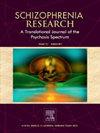Myocardial mechanics in schizophrenia and bipolar disorder: A gap to fill
IF 3.6
2区 医学
Q1 PSYCHIATRY
引用次数: 0
Abstract
Background
Evidence on subclinical cardiac organ damage and, particularly on myocardial deformation, detected by speckle tracking echocardiography (STE), in patients with schizophrenia and bipolar disorder free from known cardiac disease is scanty. The aim of the present systematic review was investigate whether global longitudinal strain (GLS) could be a more sensitive index of systolic dysfunction than left ventricular ejection fraction (LVEF) in this setting, after having preliminary focused on LV structural and functional changes by standard echocardiography or magnetic resonance imaging (MRI).
Methods
To identify eligible studies targeting GLS in patients with schizophrenia and bipolar disorder systematic searches were conducted across bibliographic databases (Pub-Med, OVID, EMBASE and Cochrane library) following the PRISMA guidelines, from inception up to August 31, 2024.
Results
Six studies focusing on GLS including a total of 535 patients with schizophrenia (n = 185) or bipolar disorder (n = 350), and 153 healthy controls were considered for the review. Four studies compared GLS values of patients with schizophrenia and bipolar disorder with healthy controls and the other two studies evaluated the impact of antipsychotic therapy on this index of myocardial deformation. Overall, GLS emerged as a more sensitive index in assessing early systolic dysfunction than LVEF as well as the effects of antipsychotic drugs on systolic function.
Conclusions
The evaluation of LV mechanics in patients with schizophrenia and bipolar disorder is underused despite the fact that could unmask subclinical systolic dysfunction better than LVEF. Thus, the role of STE in detecting early LV systolic dysfunction in this clinical setting needs to be further investigated in future studies.
精神分裂症和双相情感障碍的心肌力学:有待填补的空白
背景:在无已知心脏病的精神分裂症和双相情感障碍患者中,斑点跟踪超声心动图(STE)检测到亚临床心脏器官损伤,特别是心肌变形的证据很少。本系统综述的目的是在通过标准超声心动图或磁共振成像(MRI)初步关注左室结构和功能变化后,研究在这种情况下,全局纵向应变(GLS)是否比左室射血分数(LVEF)更敏感地反映收缩功能障碍。方法为了确定针对GLS在精神分裂症和双相情感障碍患者中的符合条件的研究,根据PRISMA指南,从建立到2024年8月31日,对文献数据库(pubm - med, OVID, EMBASE和Cochrane图书馆)进行了系统检索。结果纳入6项GLS相关研究,共纳入535例精神分裂症(185例)或双相情感障碍(350例)患者,153例健康对照。四项研究比较了精神分裂症和双相情感障碍患者与健康对照者的GLS值,另外两项研究评估了抗精神病药物治疗对该心肌变形指标的影响。总体而言,GLS在评估早期收缩功能障碍以及抗精神病药物对收缩功能的影响方面比LVEF更敏感。结论与LVEF相比,对精神分裂症和双相情感障碍患者左室力学的评估能更好地揭示亚临床收缩功能障碍,但其应用尚不充分。因此,在这种临床环境下,STE在早期左室收缩功能障碍检测中的作用需要在未来的研究中进一步研究。
本文章由计算机程序翻译,如有差异,请以英文原文为准。
求助全文
约1分钟内获得全文
求助全文
来源期刊

Schizophrenia Research
医学-精神病学
CiteScore
7.50
自引率
8.90%
发文量
429
审稿时长
10.2 weeks
期刊介绍:
As official journal of the Schizophrenia International Research Society (SIRS) Schizophrenia Research is THE journal of choice for international researchers and clinicians to share their work with the global schizophrenia research community. More than 6000 institutes have online or print (or both) access to this journal - the largest specialist journal in the field, with the largest readership!
Schizophrenia Research''s time to first decision is as fast as 6 weeks and its publishing speed is as fast as 4 weeks until online publication (corrected proof/Article in Press) after acceptance and 14 weeks from acceptance until publication in a printed issue.
The journal publishes novel papers that really contribute to understanding the biology and treatment of schizophrenic disorders; Schizophrenia Research brings together biological, clinical and psychological research in order to stimulate the synthesis of findings from all disciplines involved in improving patient outcomes in schizophrenia.
 求助内容:
求助内容: 应助结果提醒方式:
应助结果提醒方式:


